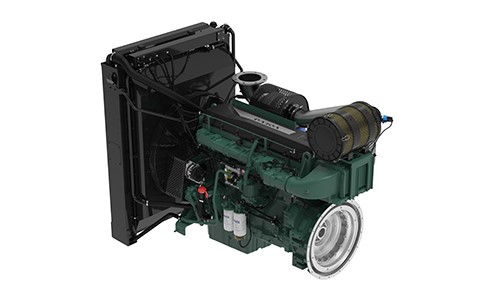
Volvo Penta has extended its power generation engine range with the introduction of its most powerful model – the D17. The highly fuel-efficient 17-litre Volvo Penta TWD1744GE industrial genset engine will help support both the current demands of industrial customers and their future business needs. Looking ahead, the D17 and the rest of the power generation line-up will evolve to enable customers to transition to significantly lower emissions utilising alternative fuels.
The D17 offers up to 5% less fuel consumption per kWh than its lower-displacement D16 sibling. This is largely the result of recent evolutions in combustion technology, such as the modernisation of the fuel-injection system with a common-rail design. An important new feature – which will also be made available to D16 models – is the option of a viscous fan to reduce fuel consumption and noise emissions further.
Volvo Penta further leveraged its existing power generation platform by adopting the D16's inline six-cylinder block as the starting point for the new design, ensuring the D17's basic footprint would remain the same. The company's engineers developed a larger bore engine, enabling the larger volume. This paved the way for an approximately 10% increase in maximum standby power over the TWD1645GE at 1800 rpm.
"Combining this with its dual-stage turbochargers means the D17 can provide much higher power from a smaller envelope, comparing favourably with larger alternatives, while offering the additional benefit of far more economical operation," says Kristian Vekas, Product Manager at Volvo Penta. "To find something with equivalent power density, you'd have to look beyond automotive-based designs – which will likely add further cost implications."
As with the entire Volvo Penta power generation range, the D17 is backed by an aftermarket ecosystem that includes extended coverage alongside the company's extensive global network of dealers – to secure performance and uptime.
Designed to power a variety of standby and prime-power generator sets, the dual-speed (1500/1800 rpm) D17 is suitable for a wide range of applications, most notably where sufficient backup electrical power must be available at all times. Like all Volvo Penta genset engines, the new unit complies with the most-stringent ISO8528 G3 standard for load acceptance, a measure of how quickly it can meet power demand in response to a blackout.
The D17's low exhaust emissions ensure compliance with UNECE REG 96 Stage 2 (equivalent to EU Stage II mobile off-highway requirements), and it is certified for US EPA Tier2 Stationary Emergency, enabling it to be used for supplying a few hours of backup power in these highly regulated regions.
"Our customers were instrumental in inspiring the D17's introduction," adds Kristian. "In addition to wanting extra power to provide more electricity, they were keen for it to retain commonality with the D16 for seamless integration."
"We've leveraged our D16 platform and capitalised on its real-world use and testing across the Volvo Group," says Hannes Norrgren, president of Volvo Penta Industrial. "We are taking our power generation offer to the next level by extending the range while developing new technologies to achieve net zero value-chain emissions."
The D17 will be displayed for the first time at Volvo Penta's stand S3.B39 at the Middle East Energy (MEE) exhibition in Dubai from March 7th-9th.













